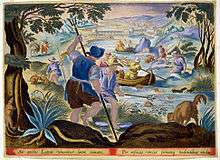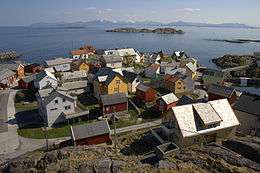Fishing stage

A fishing stage is a wooden vernacular building, typical of the rough traditional buildings associated with the cod fishery in Newfoundland, Canada. Stages are located at the water's edge or "landwash", and consist of an elevated platform on the shore with working tables and sheds at which fish are landed and processed for salting and drying. Traditionally, they are painted with a red ochre paint, though colours other than red are sometimes seen.
The stage is unique among British and North American outbuildings because unlike the typical uses of agricultural structures, both the slaughter and the processing of a harvested animal takes place within this space. While barns and stables were intended for year-round housing of live animals, the stage would be used only for several months during the summer, and not as a shelter for livestock.
— [1]
Stages, not necessarily called 'stages', are or were also found in just about every fishing village in Atlantic Canada. On the Eastern Shore of Nova Scotia, for instance, they are or were not infrequently called 'camps' because they are or were where the (usually male) fishermen would spend the week away from their families - sometimes just down the road, sometimes out on a cape or an island nearer the inshore fishing grounds. They consisted of a wharf connected to (or supporting) a shed/shack where the fishermen slept on the second storey and where the ground floor that gave onto the wharf was where much of the fishing tackle was stored and the catch was salted down in barrels or, in the case of cod livers, left in barrels or drums to extrude the cod liver oil. In the 1950s, 1960s and 1970s, the fish themselves (cod, pollock, herring (herring were not actually called 'fish') and high-value catches like halibut and tuna), were gutted or filleted on the wharf, some being salted in the barrels inside the shed, some livers being tossed into an old oil drum to render into cod liver oil (where the old-timers would sometimes put in a dipper and drink off the vile dark liquid), and some being sold to fish buyers. Fishing on the Eastern Shore of Nova Scotia continued for as much of the year as is possible to fish, and it seems this continues in 2018, though the mid-shore boats tend to bring their catch into the local fish processors. All the same, you can still buy fish fresh off the boat at the camps. (Personal observation.)
See also
References
- ↑ Gerald L. Pocius, "The House that Poor-Jack Built: Architectural Stages in the Newfoundland Fishery" published in: Larry McCann with Carrie MacMillan, eds. The Sea and Culture of Atlantic Canada (Sackville: Centre for Canadian Studies, Mount Allison University, 1992), pp. 62-105.


